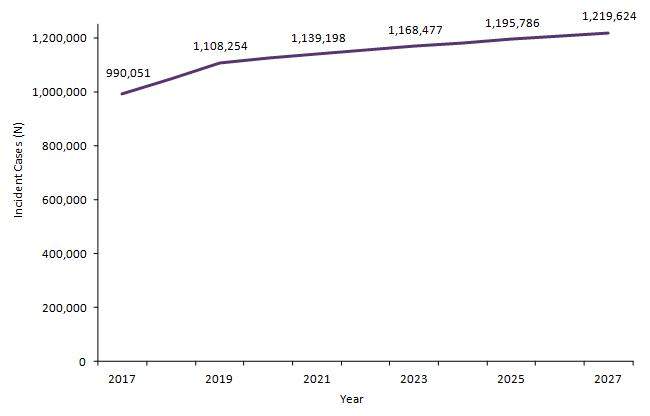
Syphilis continues to be a global disease burden with a high and growing number of new cases each year. This sexually transmitted infection (STI) is caused by bacteria and can lead to death if left untreated. Vertical transmission of the disease from a mother to an unborn baby can cause a miscarriage, still birth, prematurity, low birth weight, or death shortly after birth. GlobalData epidemiologists estimate that the number of incident cases of syphilis will increase in the next decade for the total of all countries in the 16 major markets (16MM: US, France, Germany, Italy, Spain, UK, Japan, Australia, Brazil, Canada, China, India, Mexico, Russia, South Africa, and South Korea), at an Annual Growth Rate (AGR) of 2.32% from 2017 to 2027. Figure 1 below shows the estimated number of incident cases of syphilis for the 16MM from 2017 to 2027.
Figure 1 : Incident cases of syphilis for all countries in the 16mm, both sexes, all ages, N, 2017-2027

Source:GlobalData © GlobalData
16MM = US, France, Germany, Italy, Spain, UK , Japan, Australia, Brazil, Canada, China, India, Mexico, Russia, South Africa, and South Korea
How well do you really know your competitors?
Access the most comprehensive Company Profiles on the market, powered by GlobalData. Save hours of research. Gain competitive edge.

Thank you!
Your download email will arrive shortly
Not ready to buy yet? Download a free sample
We are confident about the unique quality of our Company Profiles. However, we want you to make the most beneficial decision for your business, so we offer a free sample that you can download by submitting the below form
By GlobalDataAlthough syphilis is a curable disease, the incidence rate of syphilis has been on a steady rise over the last decade for almost all of the 16MM, especially in Japan, where the incidence rate more than doubled from 2007 to 2017. Japan also had over a 700% increase in the number of cases of syphilis from 2007 to 2017. The causes behind the spread of syphilis and other STIs may be linked to changes in sexual behavior; for example, dating apps are thought a factor in the increase of STIs. In the US, the opioid crisis is linked to the increases in sexually transmitted infections and a factor to the increasing number of cases of congenital syphilis when women trade sex for drugs. To keep up with surge in the number of cases of STIs, internet-accessed STI testing (e-STI) has become increasingly available and offers an alternative to in-person clinic testing. Online STD quizzes and risk assessments are available for free. Solutions to the rising rates of syphilis and other STIs include increasing testing and treatment services, increasing funding and resources, and strengthening surveillance systems. Finding effective approaches to educating people about STIs and safe sex is one of the most important preventative strategies that can be taken to stop the rise of STIs.




